Best D&D Encounter Builders and Initiative Trackers
One of the handiest tools to have is a good encounter builder and initiative tracker. It’s one of the hardest tasks of a Dungeon Master. Building proper encounters and to run them whilst keeping track of everything. Luckily there are tools to help you with this. If you ask me, at the moment of writing, there is one tool that is by far the most extensive and useful: Shieldmaiden. So much so, I’ve dedicated a page to it.
But to be fair, I will compare Shieldmaiden to other prominent encounter builders and initiative trackers. That way, you can see the complete list of features of each tool. And you’ll see why I prefer Shieldmaiden above any other option. I will display this in a table at the bottom of the page, for easy reading.
Full disclosure: I know one of the creators of Shieldmaiden personally. I was not asked to write this, nor do I stand to gain from his tool financially.
Reviewing Encounter Builders and Initiative Trackers
If you just want to see the complete list of features per tool, go to the bottom of the page. But if you want a more complete assessment and review of each tooling, then read on. I will go through the following services:
For each I will briefly summarize the present features, not only to inform you but also to assess what the intentions of the software are. Then I will comment on the design (the UI/UX), to review whether the tool communicates clearly what it intends to. And lastly I’ll give my review: this is where I give my opinion on the tool. I will take all the features and the design into consideration, and judge how useful it is when building an encounter, tracking initiative or running a combat encounter.
DND Beyond Encounter Builder & Combat Tracker
The official DND Beyond Encounter builder is still in beta, so it’s not feature complete. Still, it’s official software from Wizards of the Coast so I won’t be going too easy on them. Also, there’s a good chance that they’re focusing on the One D&D VTT to be their all encompassing tool. But for now, let’s review this tool for what it is.
Features
The main advantage of the DND Beyond Encounter Builder is having it be part of DND Beyond. This means that all your purchased digital content easily connects with encounters. Even though I’m not a fan of locking myself into a digital walled garden like this, the upside is very apparent. You can create an encounter, import the players from the campaign, import any monster from any module that you’ve bought, and the encounter is ready to go. When creating the encounter, the CR calculator shows the officially calculated CR difficulty. You can roll initiative automatically, and you can save and load encounters at later times.
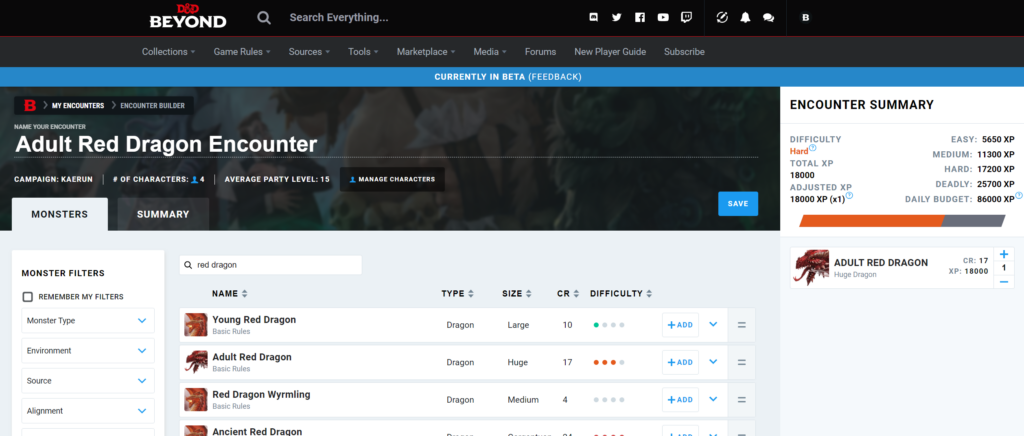
In the combat tracker of DND Beyond, the DM can click on the monsters to view their stat block, and they can click on specific rolls to actually make those rolls. By clicking on the monsters, the DM can also easily adjust their health by either ‘healing’ or ‘damaging’ them. There is no way for the DM to alter the current status of the players, other than the initiative.
Design
Both the encounter builder and combat tracker of DND Beyond have a clean and minimalistic look. When clicking on the link that leads to the encounter builder though, you automatically go into the encounter creation process. So if you want to view your existing encounters, you first go into a new encounter. Then you use the bread crumb URL on the top left to go back to the overview of encounters. This pathing is unnecessary and confusing.

The encounter builder sports a complete monster database with extensive search options. This makes it easy to search for monsters and add them to the encounter. The CR calculator immediately and clearly shows the difficulty. Within the combat tracker the minimalist and clean look gives a clear picture of the participants, their health, and their initiative. Underneath the players, their AC, passive perception and speed are denoted, which can come in handy during sessions. At the top of the page, all of the regular DND Beyond website UI is still present, distracting from the experience of encounter building and running the combat.
Review
The DND Beyond Encounter Builder is a good tool that does what it needs to do, with the advantage of having the DND Beyond content. It has the most complete database of monsters (obviously) and it’s easily searchable. It automatically accounts for CR depending on the players added, so it’s useful for this specific function. The combat tracker however, is a completely different story.
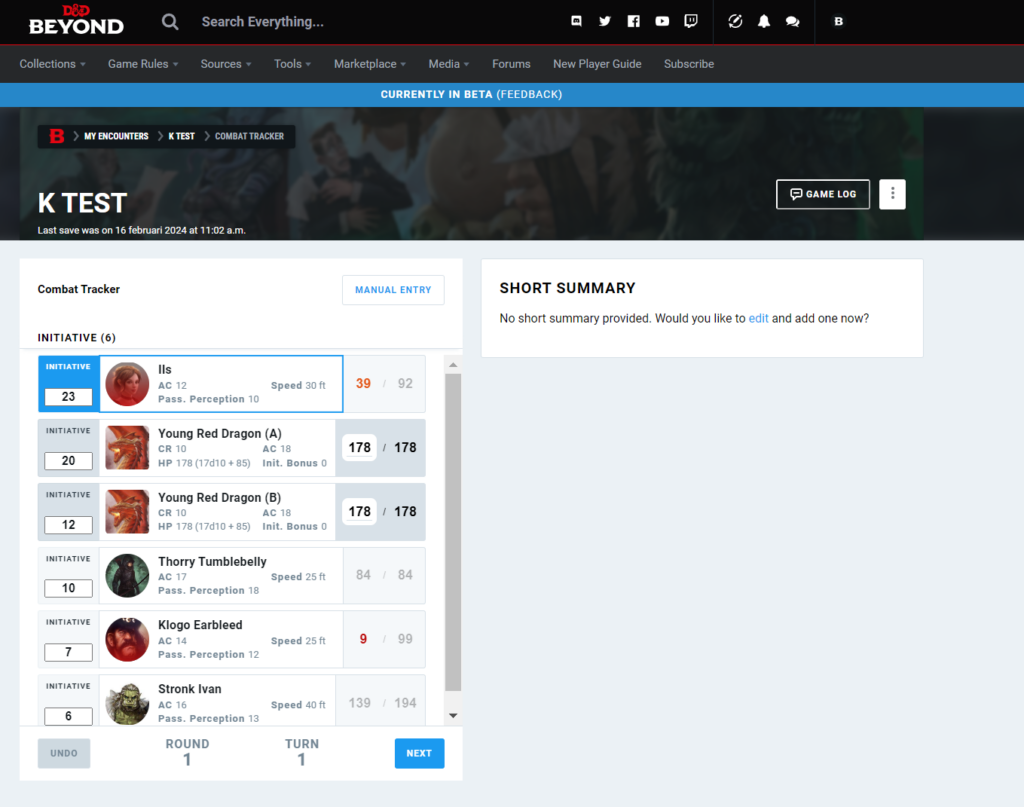
All it does is track initiative and allow you to make the rolls for the monsters, that’s it. You cannot alter anything about the player characters, because the players are in charge of their characters. That makes this tool utterly useless as a combat tracker. And because this basic functionality isn’t present, everything else that follows is missing as well. There is no way to apply damage to a player, or to set status effects and conditions, none of this. The DND Beyond Combat Tracker has less utility than a notebook and a pen. Because the main idea behind a digital helper is to remove some of the burdens of the DM: math, high amounts of rolls, remembering the current status of every player character and monster, and matters like that.
But by not having some of the most basic functions, DMs must use multiple methods of keeping track. The combat tracker is more like an initiative tracker with some easy-to-reach rolls for the monsters. That’s a nice bonus feature, but this is not a ‘combat tracker’ since the DM still has to track all of the combat. DND Beyond is severely lacking, especially taking into account that they have the official license and professional developers working on this. After all this time, this is the best they can provide?
Kobold Plus Fight Club
Kobold Fight Club has been around for a very long time. In its current form, Kobold Plus Fight Club is a pure encounter builder, aimed at helping the DM to wade through all of the monsters. It assists DMs in finding the right type of monster, but it also helps with assembling a group of monsters that fit together based on the environment. And it allows the DM to export everything to Improved Initiative, to run the created encounter there. So let’s review the tool with all of this in mind.
Features
Kobold Plus Fight Club has extensive searching filters and options, to find any monster present in the SRD. Not only can you search by name, you can search by nearly every monster feature you can think of. Alignment, size, CR, type, anything. It also allows the DM to set the number of players and their levels, in order to calculate the CR difficulty. Speaking of CR difficulty: there’s also an option to use MCDM’s ‘Flee Mortals!’-rules for creating encounters. And if you cannot find the monster you’re looking for, you can add import them using one of several easy options (Google Sheets, CSV, JSON).
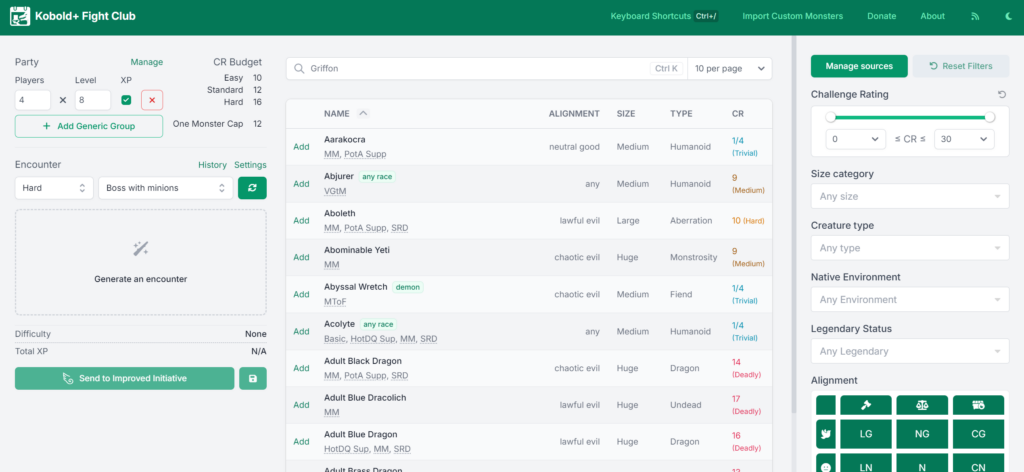
Especially helpful is the ‘generate encounter’ function, where the tool will randomly grab monsters and create an encounter. However, you as a DM can control this randomness. You can ask for a fully random encounter, a boss, a boss with minions, a duo, a trio and a horde. And when you apply filters, like the environment filter for example, the encounter generation will stick within your selected filters. So if you want a horde of neutral aquatic monsters, you can easily select and generate an encounter, and alter it to your liking. When done, you can export it to Improved Initiative.
Design
The design of Kobold Plus Fight Club is modern and functional. There are three sections: the left section holds the encounter, the middle section features the database of monsters with basic text search, and the right section comprises all the filters for monster searching. It has a simple and minimalistic color scheme using greens and grays, only deviating from it for cases like removing something or denoting CR difficulty.
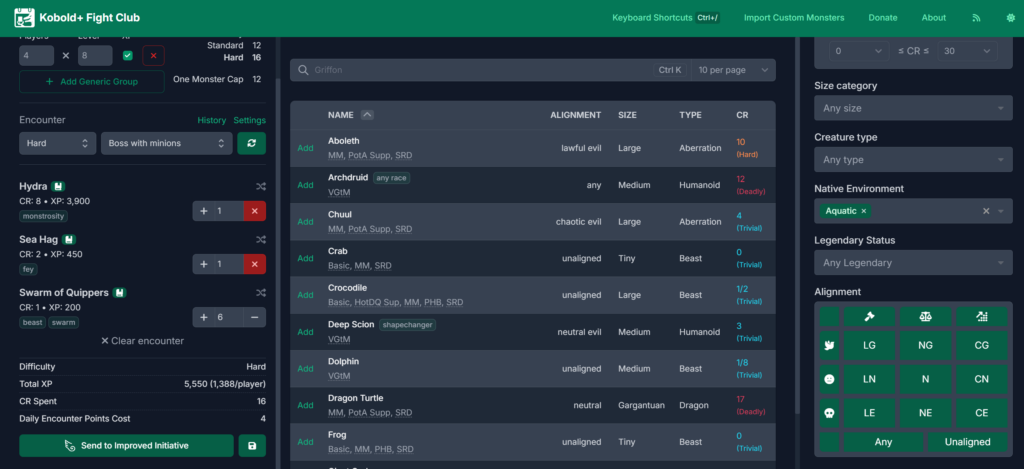
The screen’s filled entirely, which can give it a little bit of a cluttered feeling when glancing quickly. But this is done for a reason: the tool never travels to other pages, everything is placed within one screen, making it very manageable. At the top of the page are buttons to display the keyboard shortcuts and to switch to light/dark mode.
Review
Kobold Plus Fight Club is a great encounter builder that has everything you could wish for. They have a fully searchable database of the SRD monsters, with all of the most important filtering options, amongst which ‘environment’. The encounter generation tool that features different types of encounters (like ‘boss with minions’, ‘horde’ et cetera) is extremely handy. It’s a great way for some inspiration, by setting the filter to an environment and rolling some encounters.
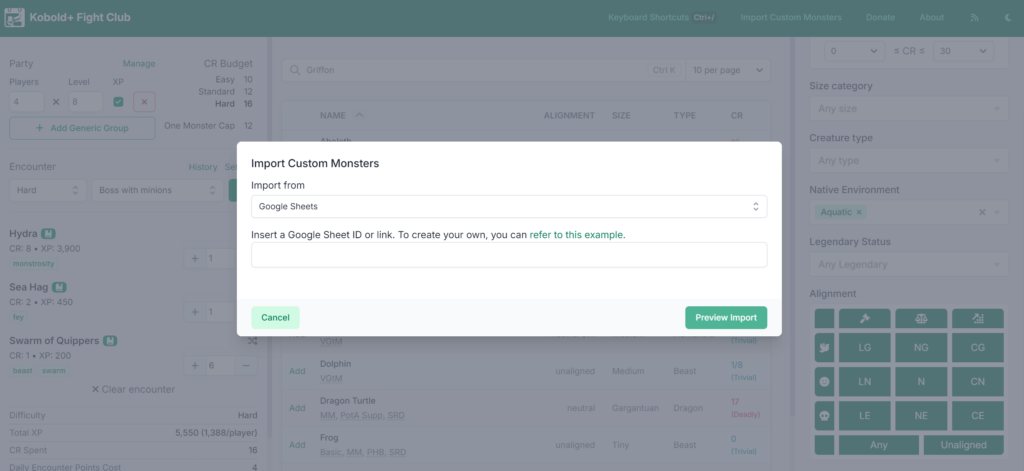
All of this is aided by modern design that clearly denotes all required details. This allows the DM to easily navigate between the three sections. And while it’s true that the encounter builder features are less complicated than combat tracking features, a good tool should still be commended for delivering. As an encounter builder, Kobold Plus Fight Club totally delivers.
Improved Initiative
Improved Initiative is an encounter builder and initiative tracker, with the focus on tracking initiative (obviously, considering the name). Using Kobold Plus Fight Club, a DM can create an encounter and export it to Improved Initiative. The tool also allows for some rolls to be made, but the main focus is to track the current status of the combat and to be able to display this for players as well.
Features
While encounters can be created, this feature only contains the bare necessities. The DM can text search for monsters, or look for them per grouping by cycling through different sorting options. They can be added to an encounter, like the players, and the encounter can be stored. Improved Initiative also allows for player information to be added so the players can be easily added to every encounter at a later point.
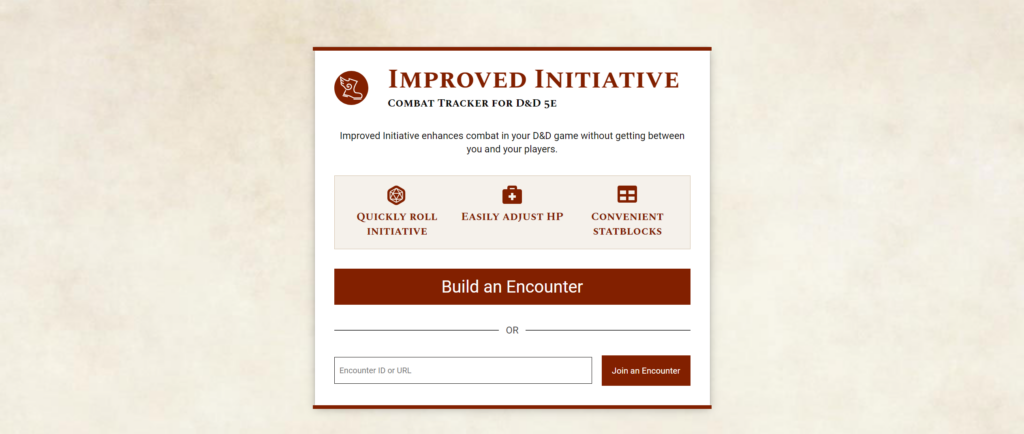
Once the combat starts, initiative can be rolled automatically (and altered, if needed), and the tracking begins. The DM can select participants, apply damage or healing, remove them from the encounter, move them in the order, or make quick alterations to AC and max HP. By clicking on a monster, the stat block opens and clicking on specific rolls will automatically roll the damage. The DM can then move along the turns to complete the round and repeat. There are also some extra settings, like showing the monster health or not, setting a timer per turn, and matters like that.
Design
Improved Initiative has a very D&D-esque color scheme with the parchment paper-like background and the burgundy red elements. There are three main sections dividing the screen, and a menu that can be collapsed. The left section shows the player or monster whose turn it is. In the middle we see the initiative order, with names, health and AC. On the right is a section reserved for whoever the DM has clicked on. There is a collapsable menu that holds several important functions like the ‘next turn’ button. And in the bottom middle of the screen there is a collapsable combat log. Both collapsable menus are an off-black color.
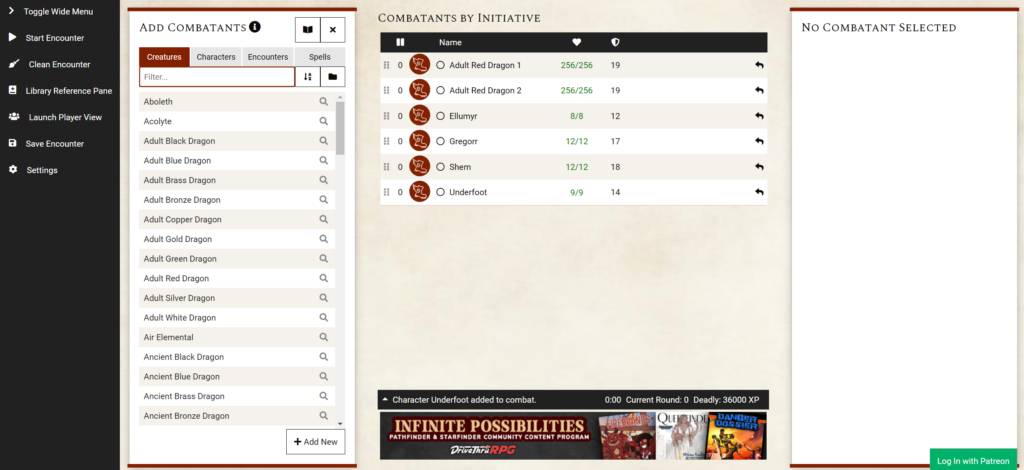
Several notable options are stowed within the setting, like a round counter and the timer. There are icons on the bars of the encounter participants, allowing the DM to demarcate reactions used, add tags, or hide the participant entirely. The pathing unintuitive, since ending an encounter does not lead the DM back to an overview of encounters. Worse yet, once an encounter has started, there is no obvious way of returning to encounter creation other than refreshing.
Review
To be very honest: Improved Initiative is a mess. Yes, you can track the initiative order. But a very common and obvious feature like how many rounds along the current encounter is, is hidden within the settings. And even once it’s added, it’s crammed on top of the combat log bar. Rolling damage works, but the results pop up in the middle section for no obvious reason other than that being the only real-estate left on screen. One of the other most important features – advancing the turn count – is placed into the collapsable menu.
But most damaging of all: it’s just not helpful. As a DM, if nothing else, a tracker like this should at least make it easy to track the initiative order and the HP. But by clicking on the HP, you open up a field (in the middle section) that allows you to ‘heal or damage’ a participant by entering a number. The text in the field doesn’t explain how to heal or damage, there’s just space for a number to be entered. A positive number results in damage, a negative number results in healing. And everytime you click on the HP field of a character, another field opens, allowing you to open an infinite stack of fields for one character.
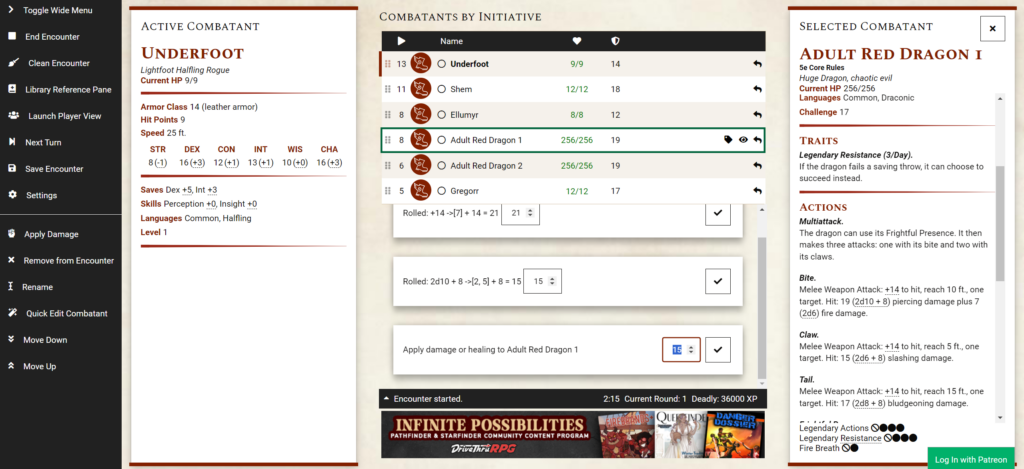
To top it off: you can quick edit combatants, but this quick edit allows you to change AC, max HP, and their name. But not any status or even their current health. This might seem trivial, but when running a combat, anything can happen, mistakes are made, so you might need to quickly fix something. And since there is no ‘undo button’, it might be handy to have the ability to simply adjust the HP if needed. It’s so barebones and clumsy that it hardly suffices as an initiative tracker. You might be better off just using OneNote or pen and paper.
Shieldmaiden
Shieldmaiden is an encounter builder, initiative tracker and combat tracker in one. It’s meant as an all encompassing tool that assists DMs in one of the hardest aspects: running combat. The tool is meant as a companion that stores all the relevant information surrounding combat. Your custom NPCs/monsters, vital player information, items, spells, encounters, anything. It also contains some extra features that help with creating atmosphere. You can create ambiences for the initiative screen that the players can see, with visual effects and a URL linking to (for example) a YouTube video with audio.
Features
Shieldmaiden contains the entire flow of encounter building. You can either create a monster from scratch or copy (and alter) a monster from the SRD by searching for it using the most important filters (name, type, size, CR, environment). And the monster stat blocks that you create or copy, hold the actual rolls (both ‘to hit’ and damage). Not only that, the monsters also hold all the saves, their spellcasting ability, resistances, immunities, everything.
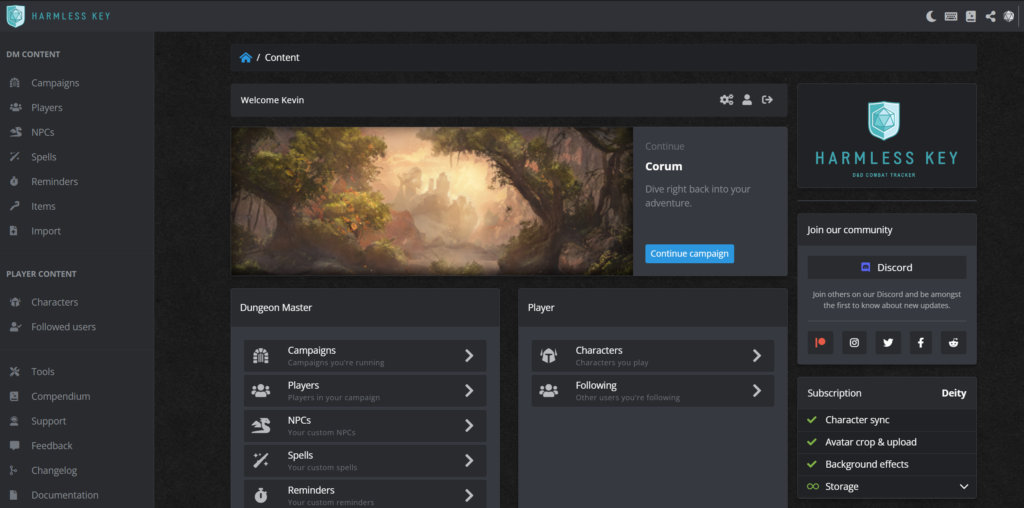
Creating the encounter is next. Here you can search for your custom monsters and SRD monsters. The CR difficulty is automatically calculated by adding monsters and players to the encounter. And you can also roll the HP per monster with one click of a button, if you want to. But not only entities can be added, the DM can set the atmosphere for the encounter to spice up the player view of the battle. And loot (both currency and items) can be linked to an encounter for easy administration purposes.
Complete Control over Combat
Lastly, the bulk of the intelligence lies within the combat tracker. Shieldmaiden allows the DM to virtually roll everything within a combat encounter, except the attack rolls from the player characters. You can go down the turn order, have a monster attack a player by clicking a prepared roll, and then apply the damage by clicking in the results pop-up menu. This entire process takes into account nearly any possibility: rolling with advantage or disadvantage, applying full, double, half or no damage, and more. If all information has been provided, then resistances and vulnerabilities are automatically applied, but you still have the option to alter the roll manually.
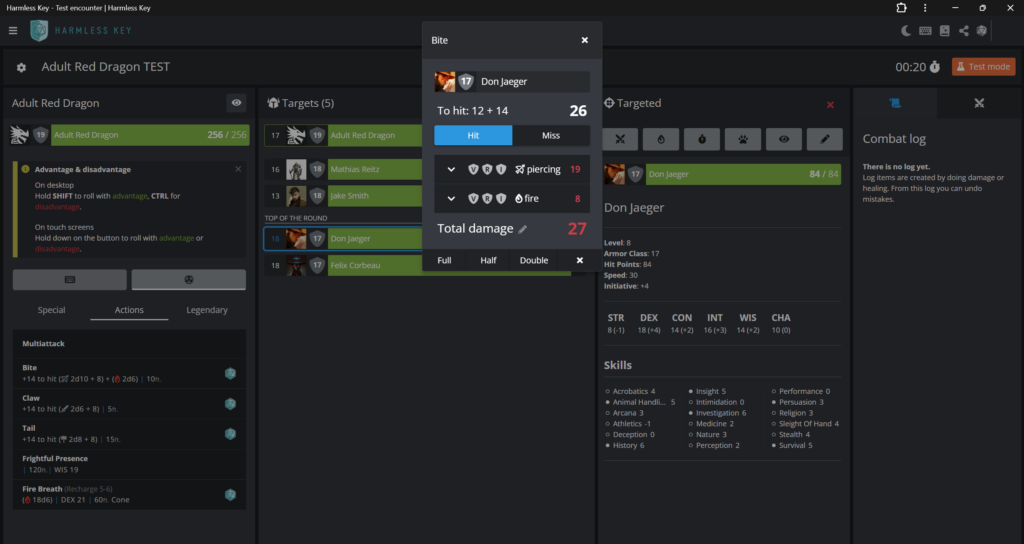
The combat tracker also allows the DM to easily apply out of turn damage, or alter any character stat within the encounter. Temporary hit points, increased AC, it’s all present. It also contains functionality surrounding conditions and reminders, like the bless spell, or the concentrating status when casting a spell. There are some standard conditions and reminders, but you can create custom ones (even during the encounter) as well.
Design
Shieldmaiden has a modern and clean design that makes their website look like an app (much like Kobold Plus Fight Club does as well). There is an ever present sidebar to guide you through all the tools, and this sidebar is only hidden behind a menu button when you’re running combat. Because Shieldmaiden contains several tools, there’s a hierarchical structure with a home screen and logical pathing. For example: encounters that you create always fall within a campaign, but NPCs/monsters, spells, items et cetera are not linked to a campaign.
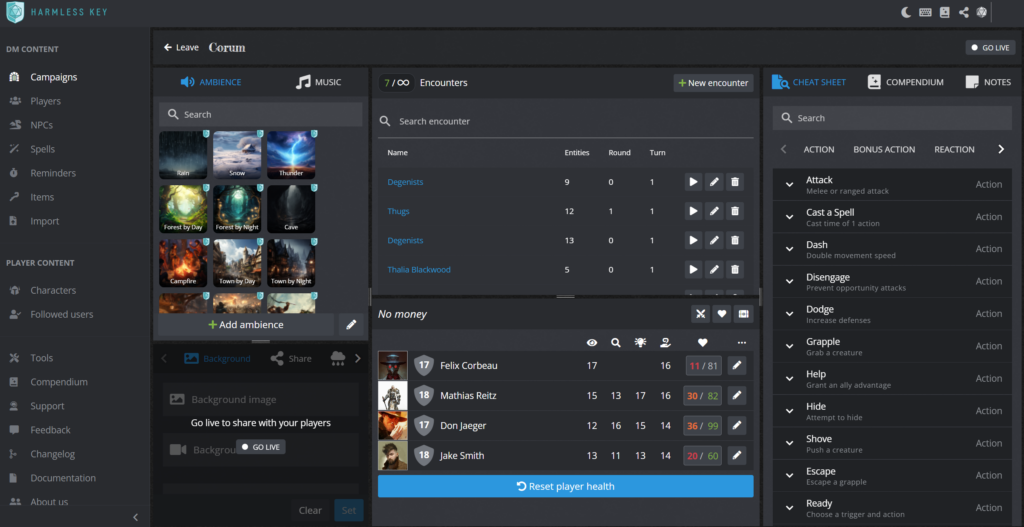
Each and every tool has a UI/UX design of its own, with a clear arrangement of sections. The most complicated one being the combat tracker, which consists of several vertical sections (like Kobold Plus and Improved Initiative). Shieldmaiden hower, has many more features to account for, and it makes use of the real estate efficiently. The turn order and rounds are clearly visible, with all combatants displayed in the middle. To the left we see the character whose turn it currently is, while the selected target is visible on the right side. There is a lot of information on the screen so and there are also extra menus that appear for specific functions. But each part of the user journey is displayed properly, with unfolding menus to show what you just clicked on and what is happening.
Color is used efficiently. There is a light theme and a dark theme, with a handy toggle at the top right, with clean and basic coloring. But the tool uses colors especially well to ascribe functions to buttons, so you will easily spot which button will progress whatever you’re doing and which button will cancel or move your current process backwards. Many other details are colored properly, like messages that warn or instruct you being red, selected icons changing colors, health bars will go from green to red depending on the damage taken, et cetera.
Review
Shieldmaiden is a unique app that provides assistance in a way no other D&D app provides, to my knowledge. The entire process of creating monsters, to building encounters, to tracking initiative, to running the combat is covered. This means that – apart from the attack rolls of the players – the tool can assist with every aspect. And because it’s built in a modular fashion with manual options for rolling or applying damage out of turn, you can easily incorporate it into your game in a way that fits you.
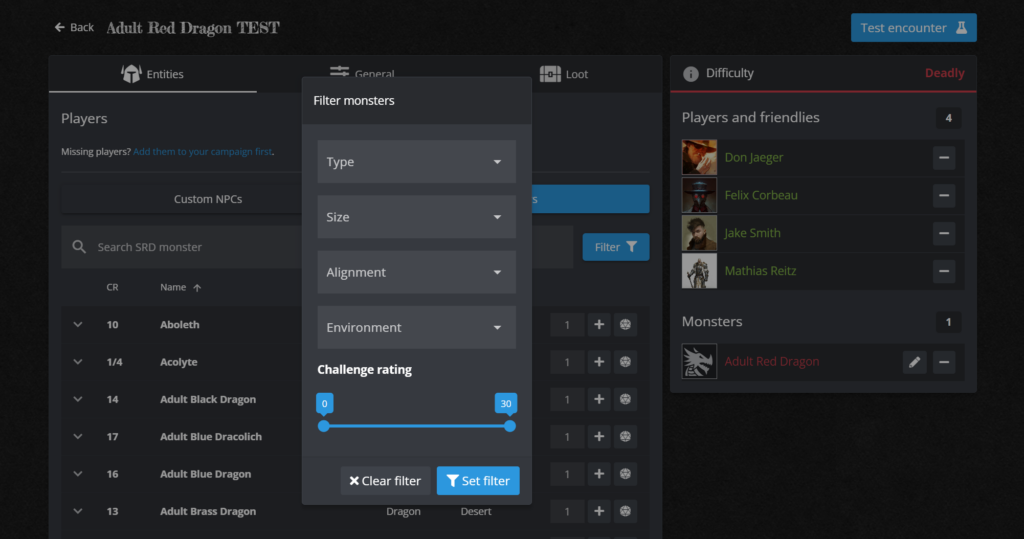
I don’t use the automated rolls for every attack, because sometimes it’s more exciting to roll on the table. Having the quick and automated option for minions, but still being able to roll manually for the boss and apply it, makes Shieldmaiden a perfect fit for most DMs. You can pick and choose which elements to incorporate in your playstyle. And just the fact that this tool has so many features that it’s not only beyond any other comparable tool, but that I couldn’t even list them in this review, should be reason enough to try it out.
Encounter Builders and Initiative Trackers Comparison Table
| Feature | Shieldmaiden | DND Beyond | Kobold Plus Fight Club | Improved Initiative |
| Initiative Tracker | Yes | Yes | No | Yes |
| Round & Turn Tracking | Yes | Yes | No | Yes |
| Initiative Handling | Yes | Yes | Yes | Yes |
| Hit Point Tracking | Yes | Yes | No | Yes |
| AC & Bonus AC Tracking | Yes | Yes | No | No |
| Roll Abilities, Saves, and To Hit | Yes | Yes | No | Yes |
| Automatic Hit & Damage Calculation | Yes | No | No | No |
| Apply Conditions & Set Reminders | Yes | No | No | No |
| Damage Types and Defenses | Yes | No | No | No |
| Combat Log | Yes | Yes | No | No |
| Targeting and Out of Turn Actions | Yes | No | No | No |
| Environmental Damage | Yes | No | No | No |
| Transformation (e.g., Wild Shape) | Yes | No | No | No |
| Dynamic Combat & Stat Updates | Yes | No | No | No |
| Encounter Builder | Yes | Yes | Yes | No |
| Monster Creation Tools | Yes | Yes | Yes | No |
| Export/Import Options | Yes | No | Yes | No |
| DND Beyond Character Sync | Yes | Yes | No | No |
| Compendium Access | Yes (SRD) | Yes (SRD and additional with purchase) | No (uses SRD) | No |
| Atmosphere & Audio/Visual Features | Yes | No | No | No |
| Player & NPC Status Display | Yes | No | No | No |
| Customizable Visibility of Stats | Yes | No | No | No |
| Full DM Control | Yes | No | No | No |
| Finished Encounter View | Yes | No | No | No |
| Soundboard and Ambient Sound Features | Yes | No | No | No |
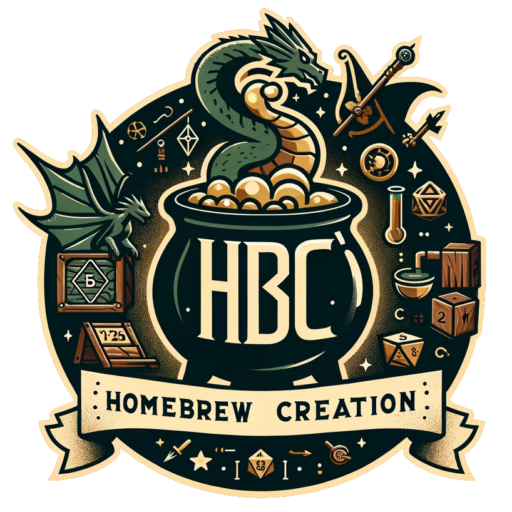
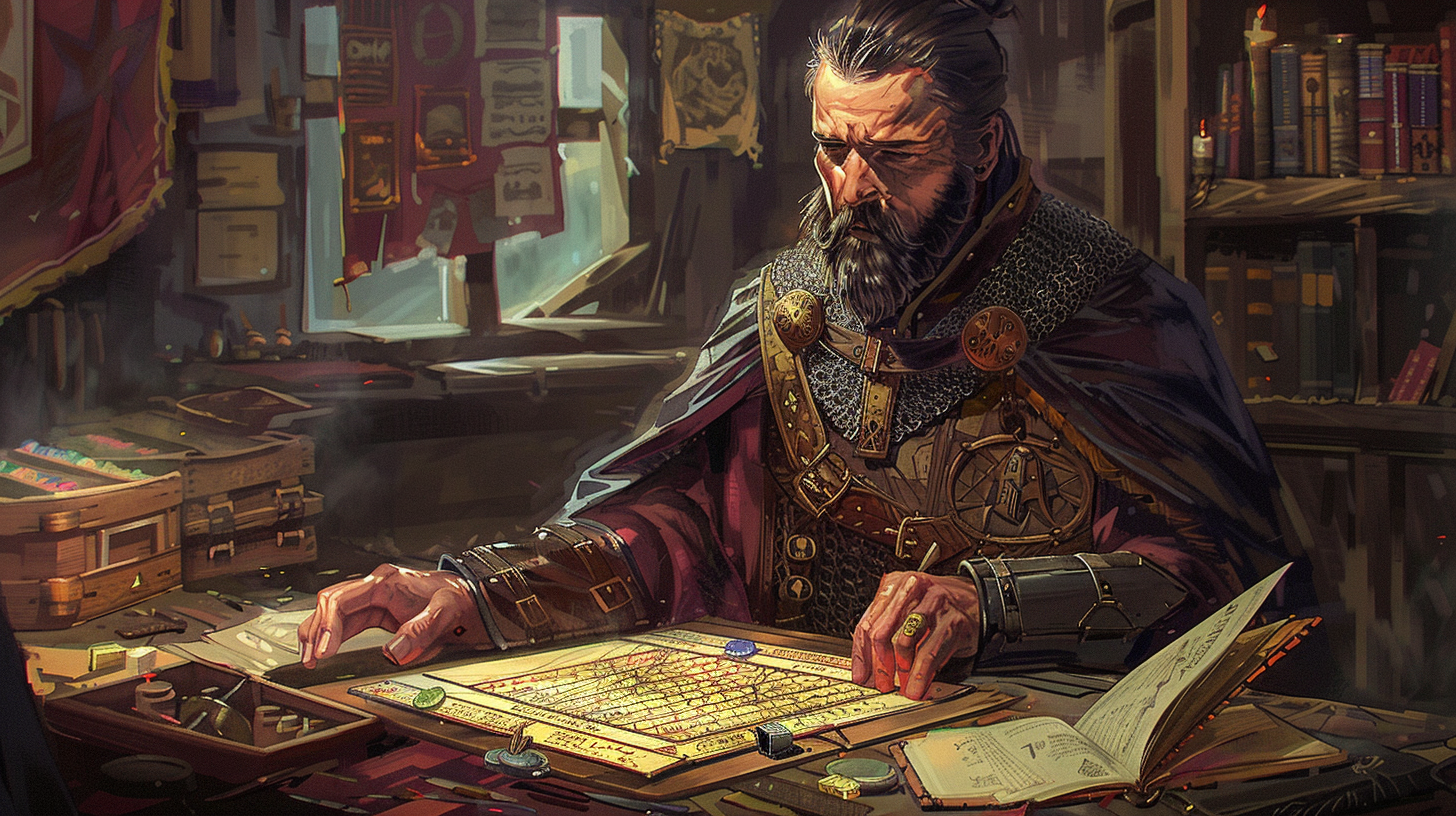
Great reviews. I love the sound of Shieldmaiden. Thanks for the comprehensive breakdown.
You’re very welcome! Thanks for commenting!